Get Rid of the Rats in Your Barn
Let’s face it, rats are the worst! Mice too. But how do you safely, naturally, and effectively get rid of the rats and mice in your barn, shed, or home? We found some really simple solutions. Let’s dig in!
We have a rat problem!
When rats invade, sometimes we’re not quick to admit it. Not even to ourselves.
About midway through this past winter on our homestead, I started to notice some signs of rodents in our barn. A hole dug here. Some droppings there.
But, between our fourth child on the way, wrapping up a bunch of projects prior to her birth, and Joelle breaking her leg on top of all of it, there wasn’t time to think about it, let alone deal with it.
Fast-forward to early spring, and it was no longer a small problem. One night I had to go out after dark to check on something in the barn. I flipped on the light, peeped in the chicken coop, and to my shock and horror it looked like the ground was moving.
This was no singular rat. It was a whole beady eyed rat colony!
This meant action. This meant war!
Signs That You Have a Rat Infestation in Your Barn
Rats in your home or outdoor spaces can start subtle. But if they take up residence, it won’t be long before you notice signs of their activity everywhere.
Here’s some common signs of rat infestation that pop up:
Large Holes
Rats are proficient diggers. We started noticing one or two holes a couple inches in diameter along the base of our chicken coop. After a couple months, these holes turned into an intricate web of tunnels giving the rats free access to our chicken coop.
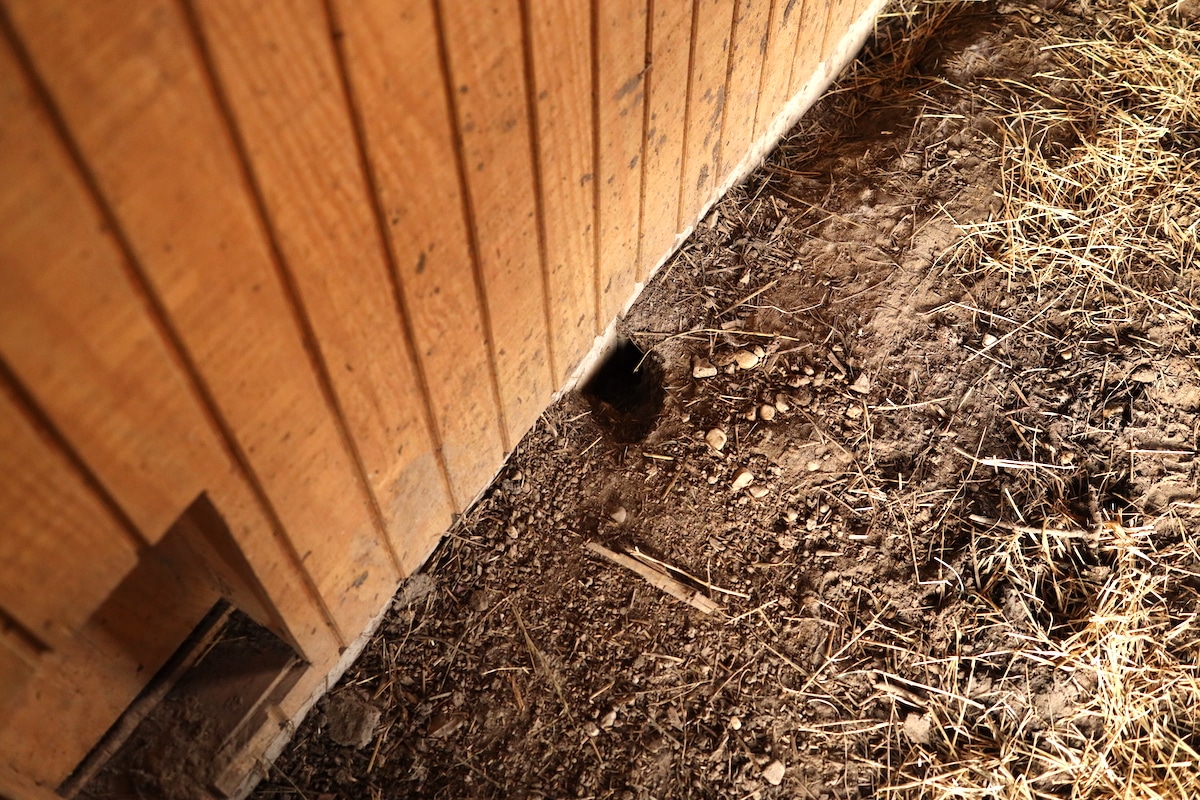
Strong Odors
After the rats are established and build a nest, you will begin to notice a strong ammonia smell from their urine and feces. Gross, but a surefire sign your rat friends aren’t planning on moving out any time soon.
Increased Feed Consumption
If you’re dealing with rats in a barn, you likely have feed around for your animals. I had thought our chickens were just getting extra hungry during the cold winter months as their feed consumption increased noticeably. I was wrong. The chickens were having their fill during the day and the rats at night.
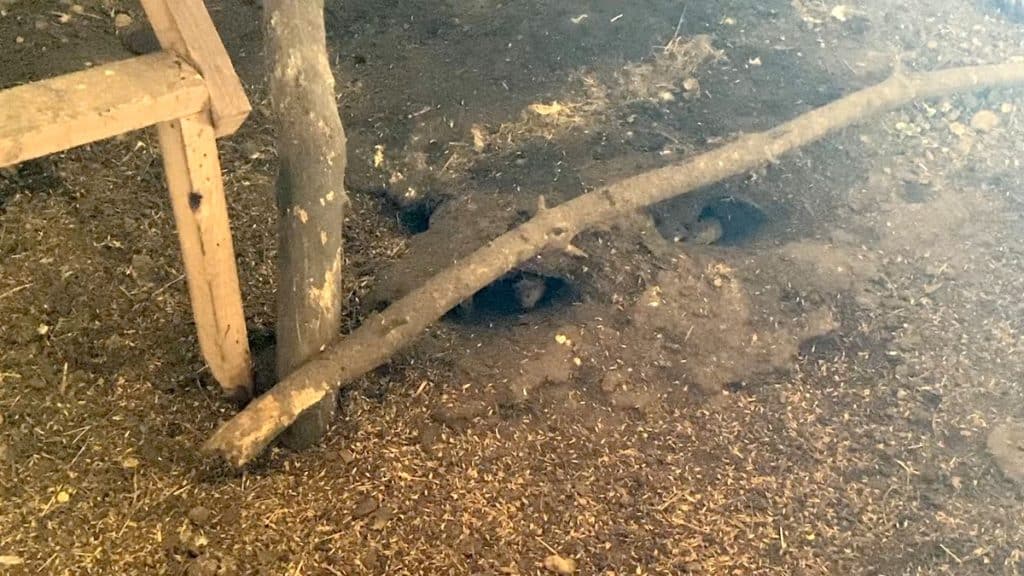
Damaged Feed Bags
After removing the chicken feeder at night, it was only a matter of time before they found the bags of feed I had stored in the livestock trailer. They didn’t do me any favors and just target one bag. Each of the 10+ bags I had stored was speckled in 1” holes and feed spilled everywhere. Taping up the holes, cleaning things up, and relocating the bags to the garage was not a fun task.
Nibbled Chicken Toes
One day I noticed some fresh blood on one of the roosting bars in the chicken coop. Chickens can be heavy dozers and it turns out rats will nibble at chickens feet while they’re asleep.
Missing Eggs
This can be hard to trace, but if you start noticing eggs mysteriously missing or damaged in your coop, it could be a sign of rat infestation. Rats are large enough to carry them off and bust into them.
Rat Sightings!
And when there’s enough of them, you’ll just start seeing or hearing those rascals. They kept quiet and didn’t show themselves for quite some time. But at some point the encounters turned to almost daily.
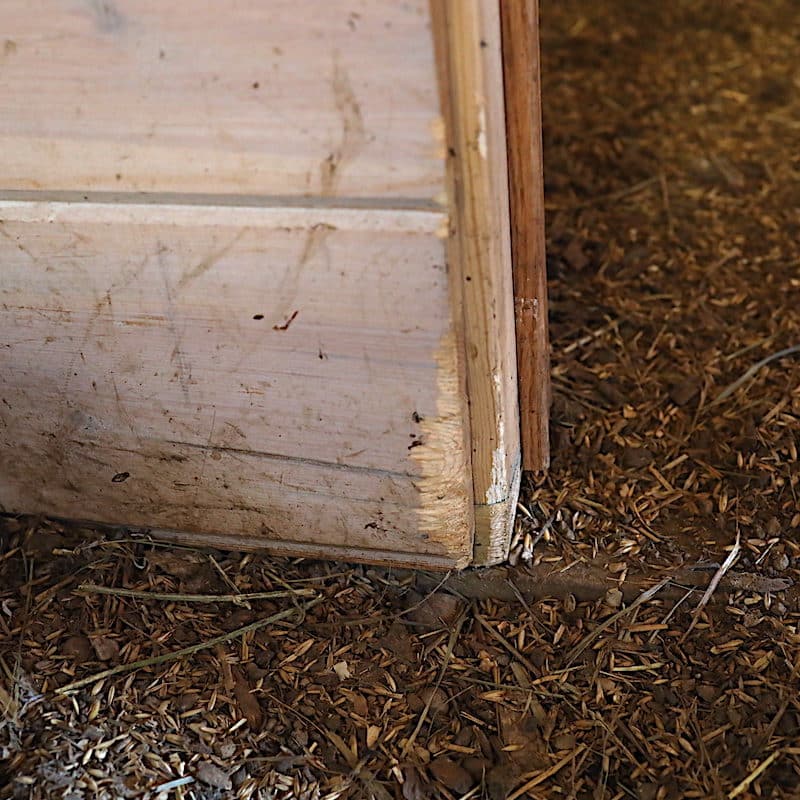
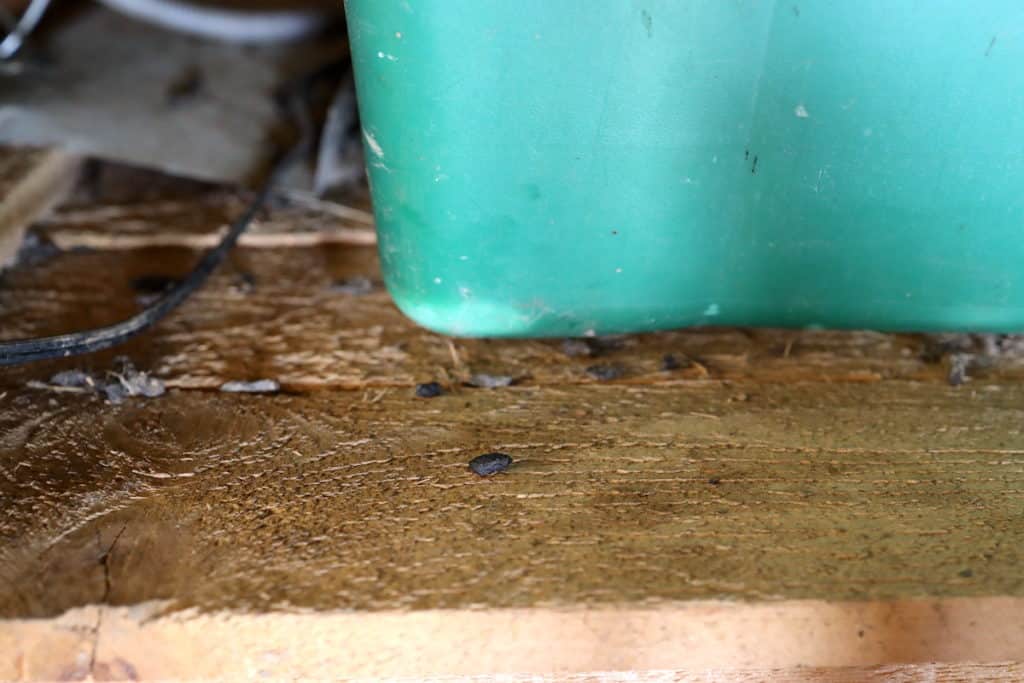
Our Early Attempts to Get Rid of the Rats
Our rat problem was quickly getting out of hand. A barn cat sounded appealing but we weren’t ready to take on one more animal on the farm. And poison bait stations is the obvious quick solution, but the chance of our chickens or Livestock Guardian Dog also getting poisoned in the process seemed too risky.
We did try two methods early on that were not going to cut it in our barn:
1. Getting some rat traps was a logical first step. Think of your standard mouse trap, but much larger and little easier to operate. I set it up every night for a week. Each morning the trap was set-off, but no rat in it! Finally, after many tries, the trap got one small rat. But with the number of rats I was dealing with, I’d need a whole fleet of traps! At $5 each that wasn’t going to happen.
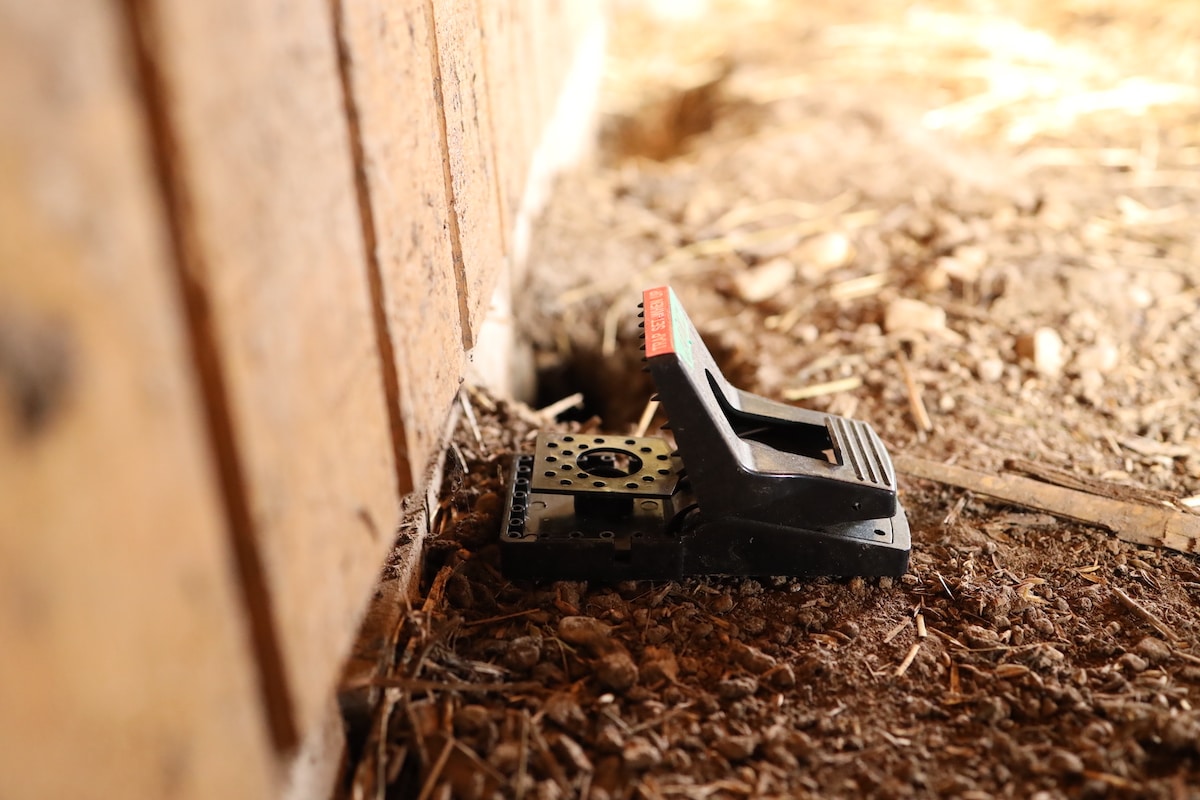
2. Next, aromatic deterrents kept coming up in our research. We bought a natural botanical deterrent called FreshCab that had raving reviews. I placed the botanical packets strategically around our barn where I knew rats were lodging. This seemed to shake things up for a day or two. But they either just relocated to a new spot, or maybe even learned to deal with the scent. While that might work great in certain applications, like the cab of a car, a barn was just too big a space. The rats were still as strong as ever.
It was back to the drawing board. Clearly we needed something a little more heavy hitting.
What Worked – Home Remedies to Get Rid of Rats
After trying those options we were in no way ready to give up and accept the reality of becoming rat landlords.
So, we did some research, reached out to other homesteaders on social media, and came up with some promising methods to evict our tiny tenants—who really weren’t so tiny anymore.
The Baking Soda Method
We first came across a YouTube Video that claimed a mixture of baking soda, sugar, and cornmeal (or flour) can effectively take care of rats. But how does it work?
Rats are drawn to the sugar. Since the ingredients are all mixed together, a hungry rat will also consume a significant amount of baking soda.

The baking soda reacts with the acids within a rats stomach producing carbon dioxide gas. Mix baking soda with vinegar and you can see the result first hand!
While rats have the ability to fart, they can’t burp or vomit. This leaves them unable to handle the internal expansion of gasses when enough baking soda is consumed.
The gas will build up within their system and eventually lead to rupture. Give it a bit of time and your rats will die off one-by-one after consuming the baking soda mixture.
The Plaster of Paris Method
Much like the baking soda method, mix Plaster of Paris with sugar and cornmeal and you have an even more deadly rat remediation method.
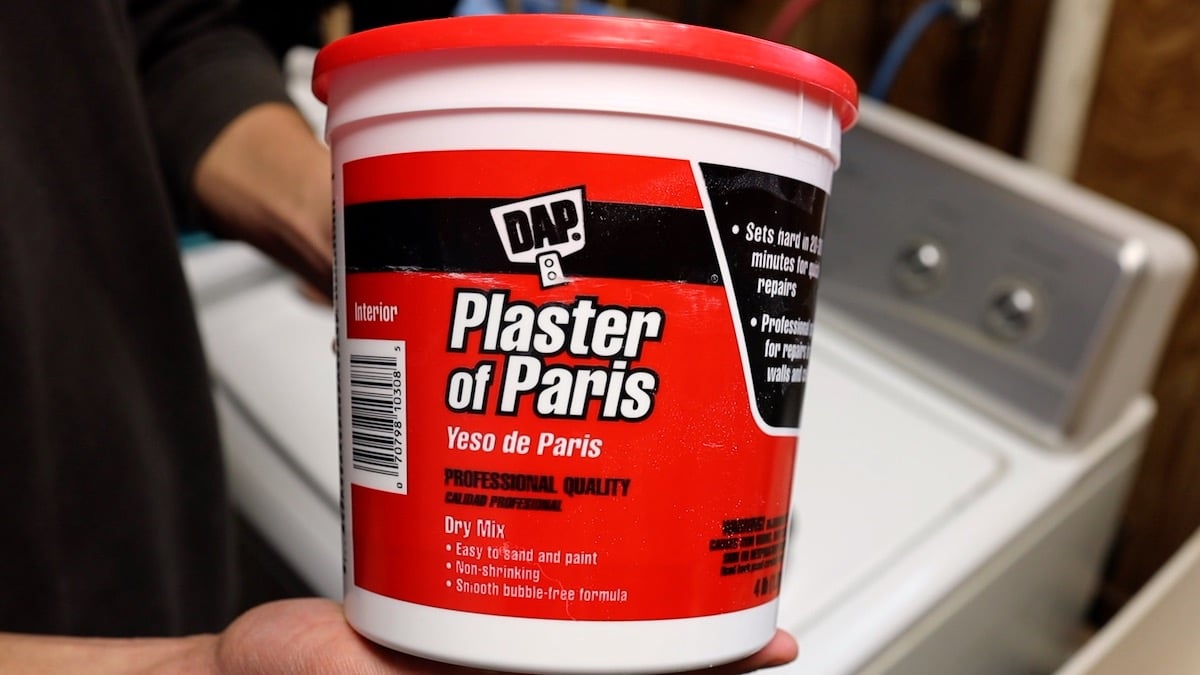
Plaster of Paris is a powdery compound commonly used to patch plaster walls. When mixed with water it forms a paste that dries rock hard in about 20 minutes.
After a rat eats it, the plaster of Paris will mix with liquids and harden up inside a the rats digestive tract. Rats won’t survive long after that.
We were recommended the plaster of Paris method by someone in Chicago who successfully took out a colony of city rats!
How To Kill Rats with Baking Soda or Plaster of Paris
The makeup of these two rat removal methods is almost identical. Mix baking soda or Paris of plaster with an equal amount of sugar and cornmeal. Here are the steps we took:
Step 1 – Create Containers
You need a simple container to dispense your mixture from that rats can get in and out of. Any plastic food containers with a lid will work great. Think quart sized yogurt containers, takeout containers or those Ziplock food storage containers.
Cut a 2-3” hole in one side of each container. We used an Exacto knife but you can use a box cutter, scissors, or any other tools you have. You want it big enough for a rat to fit in and out of.
Since we had so many rats, we eventually realized we needed to upgrade. I took a 5 gallon bucket with a lid and cut a few 3” holes near the base. This worked great and held much more of the mixture.
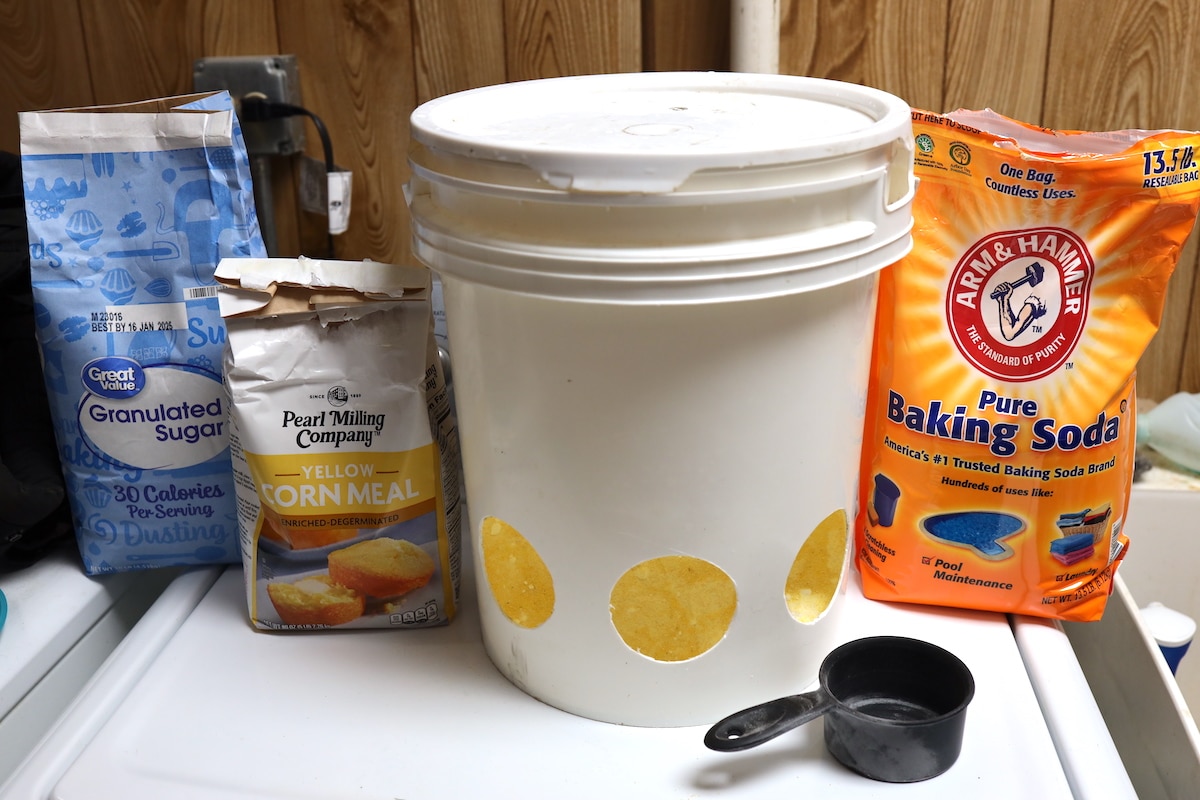
Step 2 – Mix Ingredients
Mix at a 1:1 ratio. One part of the baking soda or plaster of Paris mixed with one part of sugar and cornmeal (or flour).
For example, you can mix 2 cups of baking soda or plaster of Paris with one cup of sugar and one cup of cornmeal. The ratios are somewhat flexible and don’t need to be exact.
Break up any large clumps of baking soda that are found. If you are using a cornmeal mix that already contains sugar or a sweetener, you may be able to omit adding extra sugar.
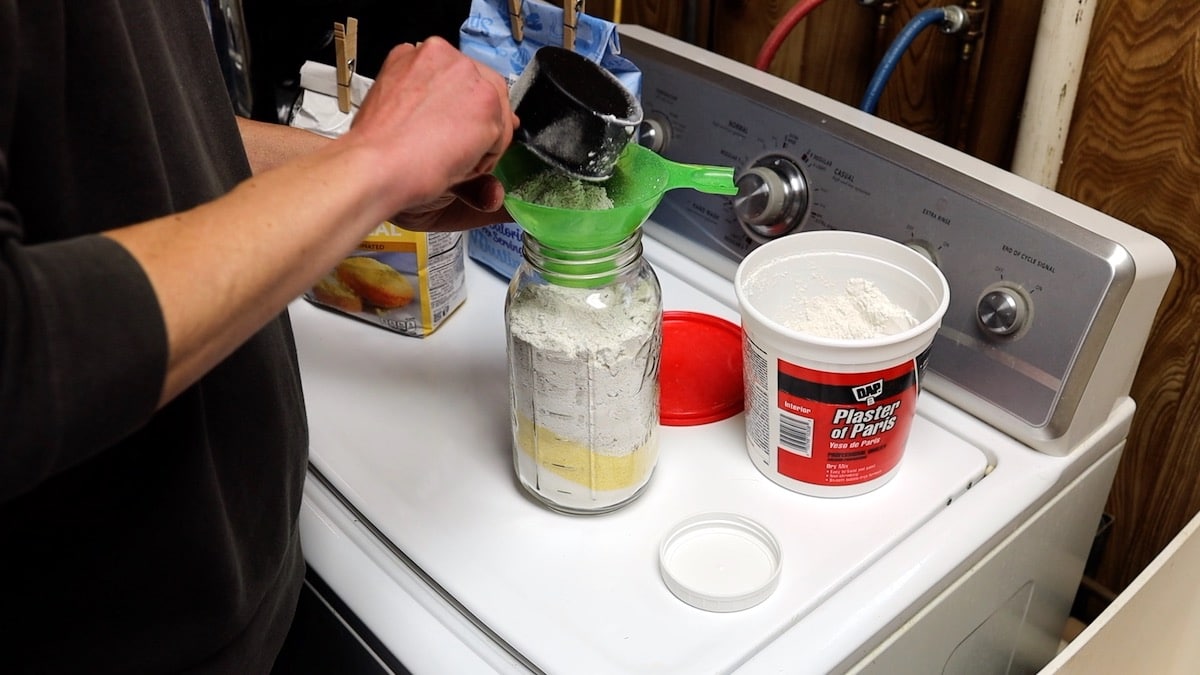
Step 3 – Fill Containers
Pour your baking soda, cornmeal, sugar mixture into your containers and secure the lid on top.
Our small containers typically only held about a cup of the mixture. The 5 gallon bucket was able to easily hold several cups or more.
Step 4 – Place Containers
Place your containers where the most activity has been observed. Often this will be along walls, where nests are observed, or around sources of food like garbage cans or animal feeders. Make it as easy for the rats to notice and get to the containers as possible.
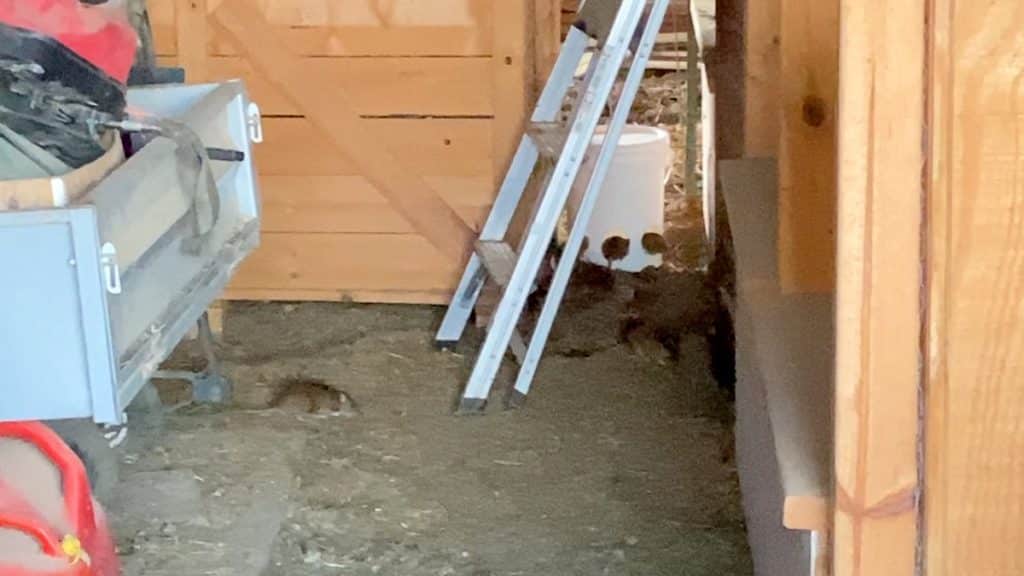
Step 5 – Monitor Containers
Check on your containers daily. Look for evidence of the baking soda/plaster of Paris mixture being eaten. If the rats don’t seem to be finding the containers in that spot, try relocating to a new spot.
Step 6 – Refill As Needed
Depending on your situation, the mixture may entirely disappear overnight, or it may dwindle down over days or weeks. Keep an eye on them and refill as needed.
Instead of bringing the containers back inside and refilling them, we found it easiest to mix up the concoction in a jar and refill at the location of the containers. The traps may get messy over time and this helps you avoid bringing those traps into your home.
Does Killing Rats with Baking Soda or Plaster of Paris Work?
Yes! Just not as immediately as an option like poison.
We found our rat population to slowly dwindle down over the course of weeks. Of course, we started with a rather large amount of rats. If you have a smaller population, you may find the baking soda or plaster of Paris method to work much more quickly.
Remarkably, we never found a dead rat. But we didn’t necessarily expect to either. We heard from others with similar infestations using this method that only one or two dead rats turned up for them.
We did see other signs it was having its effect though. The biggest one was finding traces of blood along well traveled rat routes.
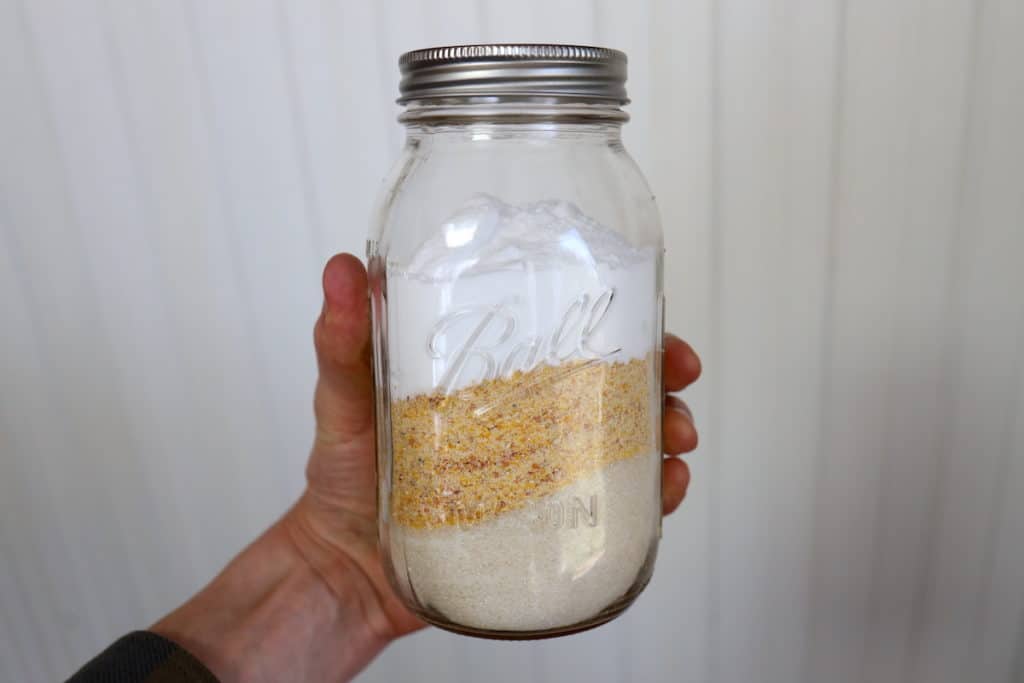
There are a couple of things we found helpful along the way.
1. Make sure the mixture is the ONLY food source available. We weren’t sure if it was working effectively until we got serious about relocating our chicken feeder during the day and completely removing it at night. When they’re hungry enough, they’ll gobble the sugary mixture down and you want to make sure they get enough.
2. Have enough available. We were finding our small containers were often completely empty come morning. Once we switched to the 5 gallon bucket, there was always plenty of capacity and we knew the rats were getting their fill of the baking soda or plaster of Paris.
3. Refill often. Something about a fresh pile of sugary mix seemed to draw them in more rapidly than when it had been sitting for a few days. We tried to refill every day or every other day.
4. Take other measures alongside the mixture. Target where they’re hiding out. Remove anything they are making a home in. Clean things up. Fill in their holes. Make them no longer feel welcome.
These rat removal methods aren’t instant. But if you stick with it and follow the steps above, those pesky rodents will eventually be no more.
Will baking soda rat traps harm other animals?
We’ve read from other sources that dogs, cats, chickens, and other animals will be safe if they consume the baking soda mixture. The unique anatomy of rats who can’t burp have a distinct disadvantage. Other animals should be able to expel the gasses that build up.
However, we didn’t want to take this at face value and let our animals have at it. Rats and mice can fit where most animals can’t, so we recommend placing your container traps where other animals can’t get to them.
For instance, I locate my traps differently during the day while the chickens are our free ranging versus at night when they’re closed up in the coop. During the day, I place the traps in a barn stall the chickens can’t get into. At night, I relocate the traps to be around the outside of the chicken coop once the chickens are closed up knowing this is a prime area for rat traffic.
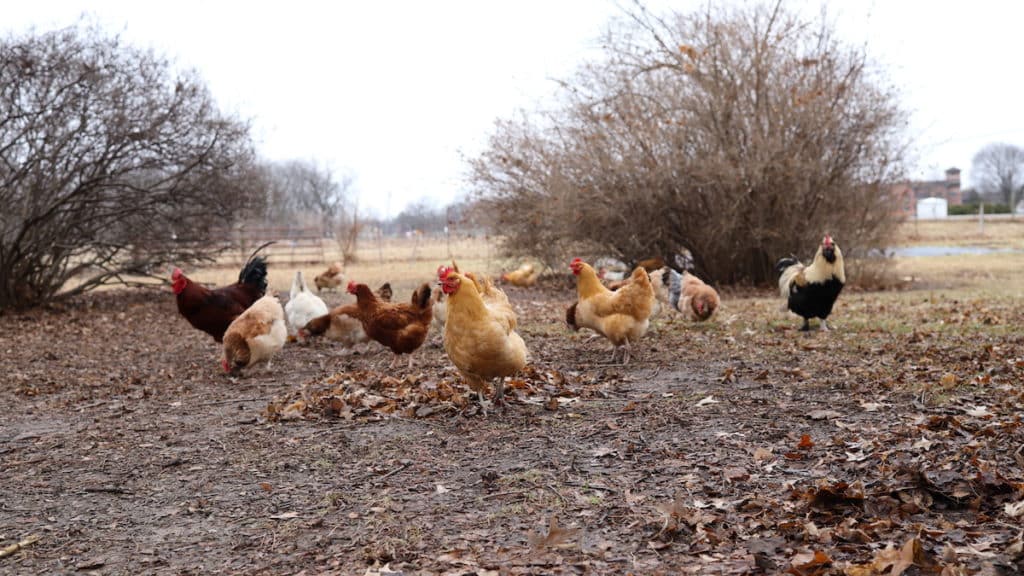
Will Plaster of Paris rat traps harm other animals?
Yes. You want to make sure your traps are not accessible to animals other than the rodents you are trying to get rid of. The plaster of Paris will have the same internal hardening reaction in other animals and lead to illness or death if consumed.
We’d recommend you either only put the plaster of Paris containers out at night when other animals are closed up. Or, create an enclosure around the trap that assures only rats can get to it.
Will Baking Soda and Plaster of Paris Kill Mice Also?
Yes! Mice, like rats, will die soon after they’ve consumed enough of either substance. We have mice pop up in our home from time to time and plan to leave a few of these traps in the attic, crawlspace, basement, garage, and utility areas to keep mice at bay in our home.
Other Methods To Get Rid of Rats and Mice
When we reached out to fellow homesteaders, we heard a wide range of methods others recommended. We haven’t necessarily tested these, but here is the list:
The Bucket Method
You can look up how to rig up this old farmer trick yourself. But in short you have a 5 gallon bucket filled halfway with water with ramp leading up to it. At the top of the bucket is some sort of spinning rod with bait like peanut butter on it. The rat goes for the bait, slips on the spinning rod, falls in, and drowns.
The Garbage Can Method
Along the same lines of the bucket method, you can also rig up a spinning dowel or trap door at the top of a garbage can that rats fall into and can’t escape from.
Raticator
The Raticator electronic rat trap advertises a more humane killing method through electrocution. Rats wander in and are electrocuted resulting in instant death. This will clearly not be your least cost option, but supposedly it works.
Terrier
Certain breeds of dogs, like terriers especially, were bred to hunt down rodents on farms and in populated areas. Many terrier breeds are exceptional rat hunters. So keeping one of these little yappers around might help curb the rat population and provide a new companion.
Barn Cats
Natures predator to rats! However, letting your cat hunt for their own food instead of keeping their bellies full all the time is key here. A pet cat that is well fed on a regular basis will likely have little motivation to go after a full sized rat. But a barn cat that’s on the prowl for dinner that night—that will make your rat invaders shake in their boots!
Bait Stations
AKA, the poison option. We don’t like using poison, but we have used them successfully in our home before for mice. The issue with this is that you have no control over where the rodent dies or what happens to them afterward. And in our barn instance, chickens or our livestock guardian dog eating a poisoned rat, and then being poisoned themselves was not the right solution. Even if it would likely have been effective in taking care of the rats.
How To Get Rid of the Rats and Mice Longterm
Once you go through the work of eradicating the current wave of rats or mice, don’t assume they won’t return! Here’s some ways you can continue to ward off future visitors before they become an issue.
Baking Soda or Plaster of Paris Traps
Keep your traps out! If you know you have trouble spots in your home or on your property, place traps in those areas. Check them monthly to see if there are signs of activity and refill or relocate as needed. Baking soda may be safer for a long-term, preventative trap than plaster of Paris. You wouldn’t want the risk of harming another animal who accidentally finds the trap.
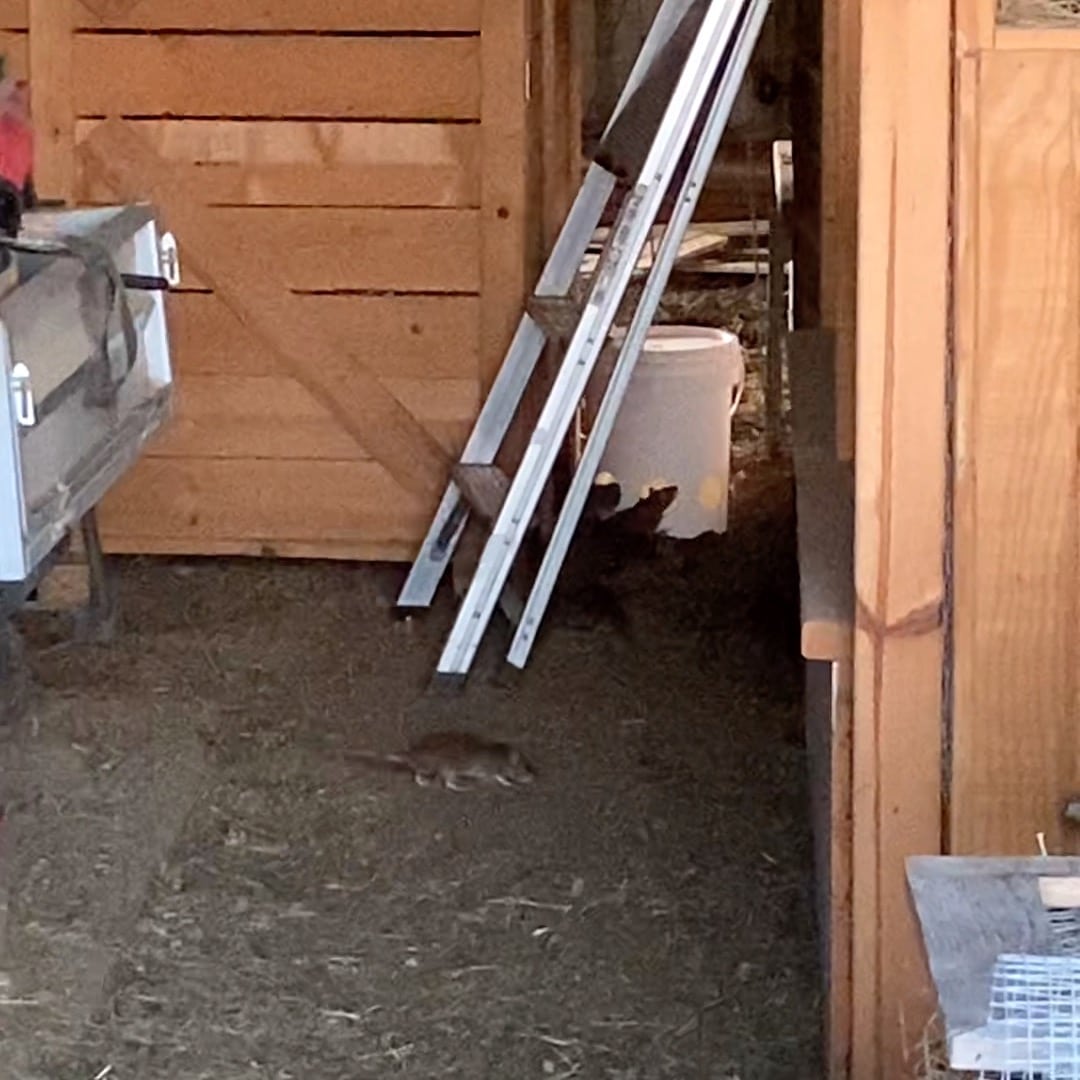
Reduce Nesting Options
Rats like to set up shop in the tightest of spaces or areas that don’t get a lot of traffic. That overturned wheelbarrow sitting there not getting use. That pallet in the corner storing materials. Or that stack of old feed bags you’ve let pile up over time. All great options for rats to burrow under and build a nest. The more you can remove those spaces and reduce clutter, the less rodent housing opportunities you’ll leave longterm.
Store Feed Properly
The rats likely came because there was a supply of food in the first place. So keeping that food protected is key. Every night, remove any animal feeders you have out and replace them during the day. Keep bags of feed stored in a rat and mouse safe space. Large storage drums or plastic storage totes with secure lockable lids can work great. We use an old refrigerator to store our open bags of feed, which gives us easy access and seals up tight.
That’s been our experience with keeping rats out of our barn. But what techniques or methods have you tried? We’d love to keep learning how to keep our spaces safe and rodent free!
Some of the above links are affiliate links. This means we earn a small commission on qualifying purchases at no cost to you. We are so appreciative of your support!
Get more insight into raising backyard chickens:
- Easy DIY Heated Chicken Waterer
- Chicken Tractor Plans for 25 Chickens
- Cost of Raising Chickens for Meat on a Small Scale
- Simple DIY Chicken Coop Inside Your Barn
- Chicken Roost Designs | Two SImple DIY Ladder Perch Ideas
Pin it for later!
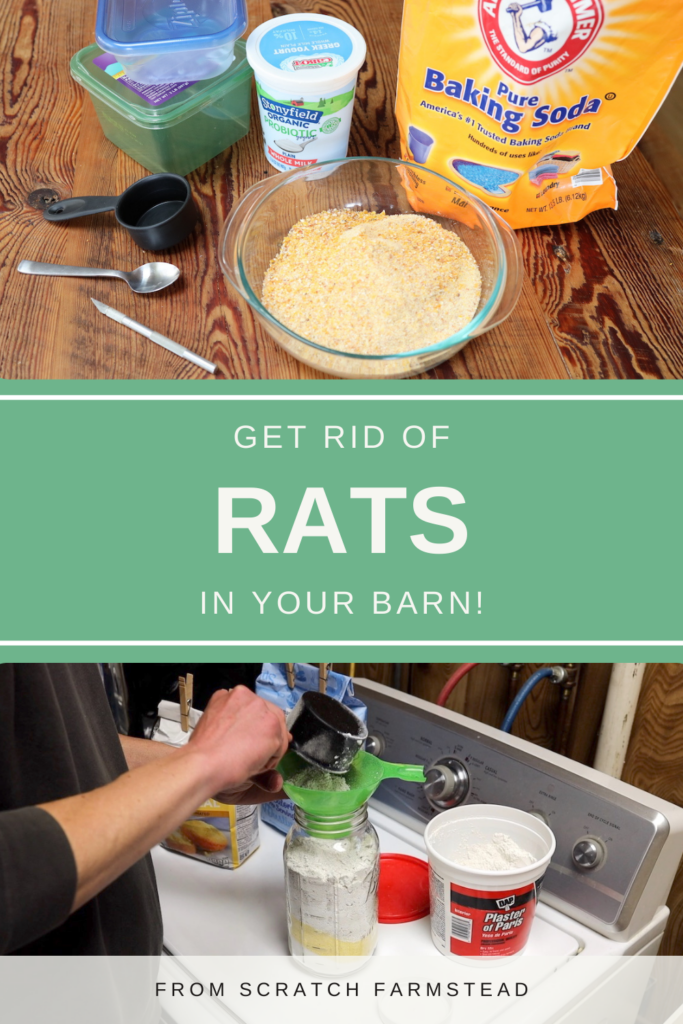

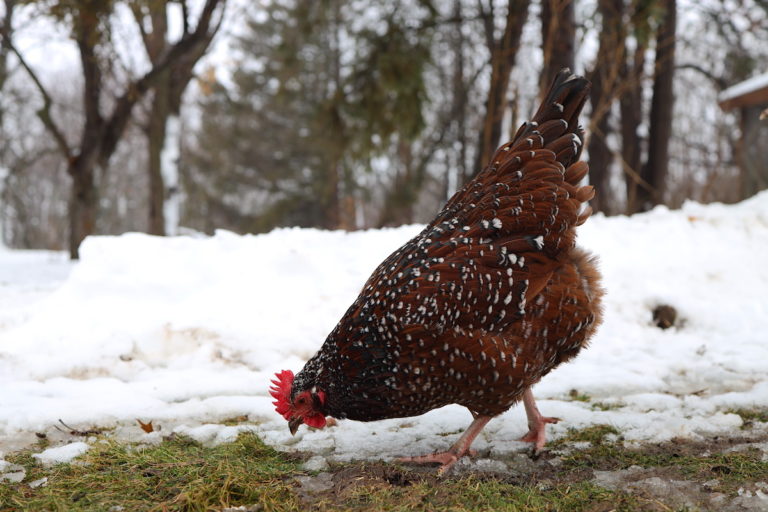

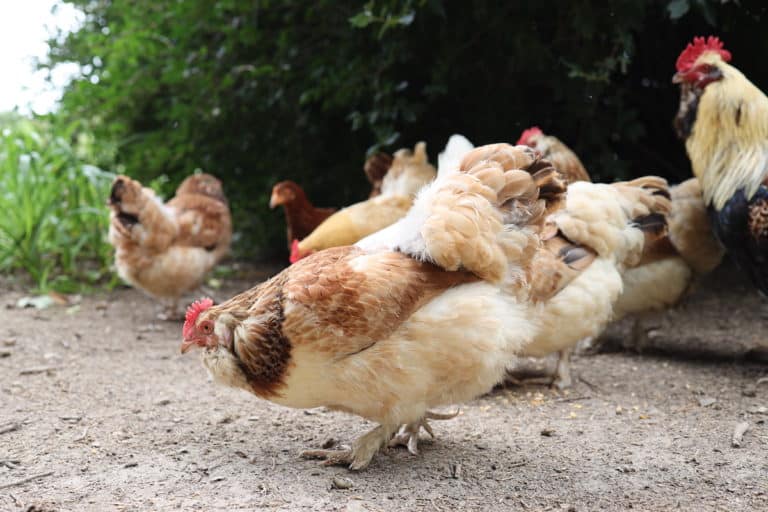
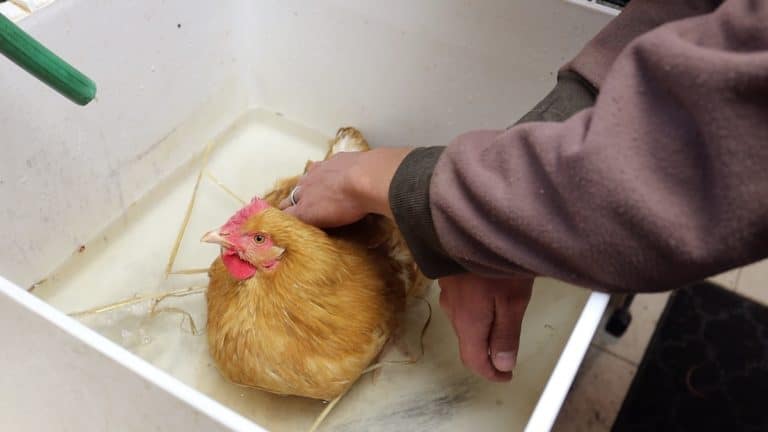

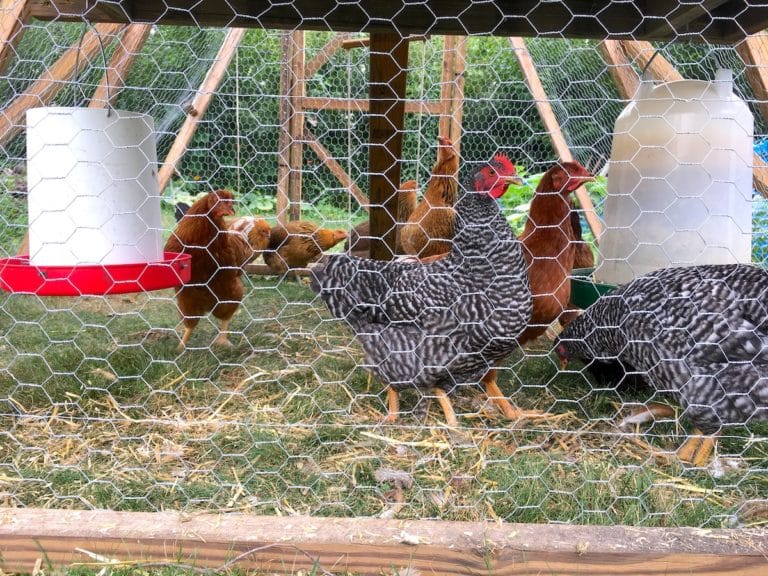
Hi. Thank you so much for this super informative post! Just yesterday we noticed rats in our shed and were thinking of ways to safely get rid of them! I’ll give your ideas a try. Thank you so much!
Glad it was helpful! Hopefully you can take care of it now before they get established!
I am assuming this works for voles, too? What about moles? Maybe they don’t have the same stomach situation. Or are there other rodents that will be affected with this “meal”?
The plaster of Paris method should work regardless. I don’t know how the anatomy between voles, moles, and rats differs, so I can’t speak to how the baking soda method would work for them. Voles are very similar to mice and rats. Not sure about moles. Thanks for stopping by and good luck!